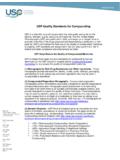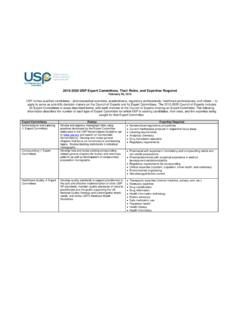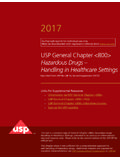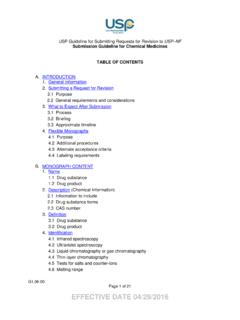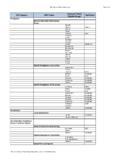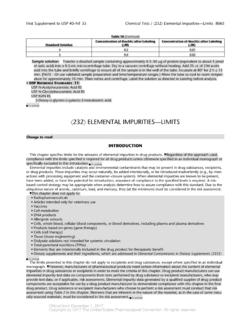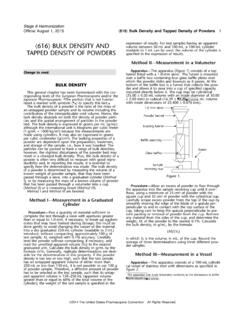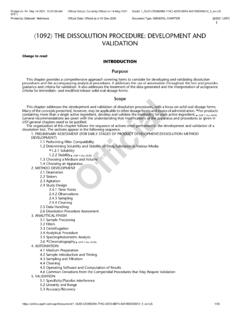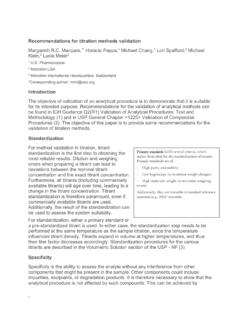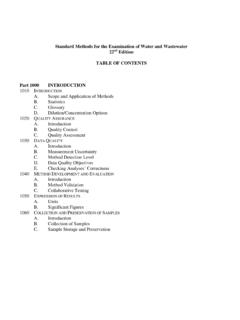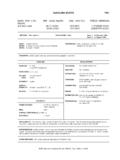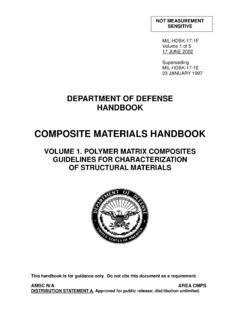Transcription of STRENGTH AND STABILITY TESTING FOR COMPOUNDED …
1 1 STRENGTH AND STABILITY T ESTING FOR COMPOUNDED PREPARATIONSi USP Compounding Expert Committee:a Loyd V Allen Jr , PhD,b Gus S Bassani, PharmD,c Edmund J Elder Jr, PhD,d Alan F Parr, PharmDe a Correspondence should be addressed to: Rick Schnatz, PharmD, Manager Compounding and Healthcare Standards, US Pharmacopeial Convention, 12601 Twinbrook Parkway, Rockville, MD 20852-1790; tel. ; e-mail b International Journal of Pharmaceutical Compounding, Edmond, OK. c PCCA, Houston, TX. d University of Wisconsin, Madison, WI. e GlaxoSmithKline, Research Triangle Park, NC. ABSTRACT Tests for STRENGTH are designed to determine how much of an active ingredient is in a sample.
2 STABILITY tests are used to determine an expiration date of a product or a beyond-use date of a preparation. Being able to understand the difference between STRENGTH TESTING versus STABILITY TESTING is the key to using the proper method to determine STRENGTH or STABILITY . To determine STRENGTH , a method may or may not be STABILITY indicating. When determining STABILITY , the method must be STABILITY -indicating. When using a STABILITY -indicating method, both STRENGTH and STABILITY can be determined. It is important that compounding practitioners understand the difference between STRENGTH and STABILITY tests and how they are determined.
3 Quality assurance programs are essential to establishing standards for COMPOUNDED preparations. INTRODUCTION The terms STRENGTH and potency are often used interchangeably, with potency being used more by the general public and STRENGTH being used more by practitioners and within the official compendia. What is the difference between STRENGTH (potency) and STABILITY ? This seems like a rather simple question, and in some respects, it is. However, the cost of a full STABILITY test for a formulation is considerably higher than that of a STRENGTH -overtime-test. To answer this question, one must understand the methods used to analyze the STRENGTH and STABILITY of a compound.
4 The most common flaw in determining STABILITY is failure to use an analytical method that has been demonstrated to be a STABILITY -indicating method. The most important aspects of determining STRENGTH and STABILITY are the methods used in the process. A STABILITY -indicating method must be used to determine STABILITY . Although STABILITY -indicating methods have the capability of also determining STRENGTH , the reverse is not so not all STRENGTH tests are capable of determining STABILITY . The purpose of this communication is to explain the difference between STRENGTH and STABILITY , why they are of importance, and how they are determined.
5 The method used to determine the concentration of the active pharmaceutical ingredient (API) is the most critical step in the process and takes into account other variables, such as solubility, polymorphic forms, and others. 2 STRENGTH STRENGTH can be described as the concentration of the drug in a product or preparation. STRENGTH tests are known as quantitative tests and are designed to determine how much of an API is in a sample. High-performance liquid chromatography (HPLC) is the typical methodology used in determining STRENGTH . HPLC is a preferred method because it is specific and efficient.
6 Although HPLC can be used in STABILITY -indicating methods , not all HPLC procedures are STABILITY indicating and they must not be assumed to be so. Other methods used to test STRENGTH include titration, which uses the principles of chemistry, and microbial assays, which are sometimes used to test antibiotics. Titration is based upon a known chemical reaction with the desired drug. A microbial assay is performed by using bacteria and the antibiotic of choice and by examining the zones of inhibition . Ultraviolet (UV)-visible spectrophotometry also can be used to determine STRENGTH , but w hen used alone (without chromatography), UV-visible spectrophotometry can determine STRENGTH only for single analytes in solutions.
7 Multiple compounds could interfere with UV absorption, resulting in erroneous results when UV-visible spectrophotometry is used alone. When performing a STRENGTH test, the methods used determine whether one will be able to determine STABILITY as well. The purpose of STRENGTH , or potency, TESTING is to establish or verify the concentration ( STRENGTH , potency) of the API in the COMPOUNDED preparation. USP has established that the acceptable range of most COMPOUNDED preparations is typically 10%, or within the range of The issue is that many STRENGTH tests do not separate the intact drug from the degradation products, and the degradation products show up under one peak in the chromatogram, thus giving the false information that the drug concentration has not changed, when it actually has.
8 A STABILITY -indicating assay, properly performed, will separate the degradation products/peaks and show the intact drug peak as it decreases in area or height, reflecting a change in the concentration of the intact drug. STABILITY , INSTABILITY, AND INCOMPATIBILITY STABILITY is the extent to which a product retains, within specified limits and throughout its period of storage and use, the same properties and characteristics that it possessed at the time of its manufacture. The United States Pharmacopeia 36/National Formulary 31 (USP 36/NF 31), in the table within general information chapter <1191> STABILITY Considerations in Dispensing Practice, provides definitions for five general types of STABILITY : Chemical: Each active ingredient retains its chemical integrity and labeled potency, within the specified limits.
9 Physical: The original physical properties, including appearance, palatability, uniformity, dissolution, and suspendability, are retained. Microbiological: Sterility or resistance to microbial growth is retained according to the specified requirements. Antimicrobial agents that are present retain effectiveness within the specified limits. Therapeutic: The therapeutic effect remains unchanged. Toxicological: No significant increase in toxicity occurs. 3 Instability describes chemical reactions that are ..incessant, irreversible, and result in distinctly different chemical entities (degradation products) that can be both therapeutically inactive and possibly exhibit greater toxicity.
10 Incompatibility is different from instability but must be considered in the overall STABILITY evaluation of a preparation. Incompatibility generally refers to visually evident and ..physicochemical phenomena such as concentration-dependent precipitation and acid base reactions, with the products of reaction manifested as a change in physical state, including protonation deprotonation equilibria . Example Some compounding practitioners have misconceptions about extending beyond-use dates, based for example on the notion of contracting with analytical laboratories to conduct a STRENGTH (potency) test that does not use STABILITY -indicating methods , running assays at time 0, at 30 days, and at 60 days.
